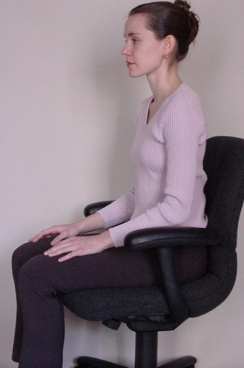 |  |  |  |  |  |  |
 |  |  |  |
|
Before you begin please take a minute to review some basic principles about stretching and strengthening. Please also review our disclaimer. If you already have a RSI or have chronic pain, please go see your doctor before doing any ergocises. Remember, never stretch to the point of pain or push yourself further than your limits. Ergocise is designed to be a gentle, relaxing program that reduces stress and tension, increases flexibility and strength and helps prevent RSIs from developing. Each ergocise begins in "neutral position." | |
| What is neutral position? | Neutral position is just what it sounds like. Neutral position is when the body is relaxed (not collapsed), lengthened and aligned. In ergocise, neutral position is used as the starting position for all ergocises. Neutral position can be either sitting or standing, either way the body should be open, released, comfortable and not holding or tucking anywhere. Let's look at neutral position both sitting and standing. |
 |
Sitting: Sit comfortably in a chair with your feet flat on the floor, toes pointing straight ahead. Your knees should be relaxed and over your heels. Adjust your chair so that your knees make a 90º angle. Place your hands on your thighs, widen your shoulders and relax your arms. Moving from the top of the spine (which ends behind your nose), move your spine so that you are neither arching your lower back or compressing it (slouching). Feel your head balanced on your spine so that it moves freely from side to side. Breathe from your abdomen. The spine has three natural curves in the cervical (neck), thoracic (upper back) and lumbar (lower back) regions. Proper alignment of the spine means keeping these natural curves supported, not collapsed or held. Don't try to flatten out any of these curves, since this results in tucking of the pelvis or holding in the neck and upper back. Picture your spine as a gentle S curve, with each vertebrae stacked gently on top of each other. When you sit, you should feel your ears balanced over your shoulders, your shoulders over your hips and your spine lifted. Sit back against the lumbar support or the back of your chair so that your lumbar curve is supported and release your upper back into the back of the chair. Keep your chin level, not pushed down or tilted upwards. Gaze straight ahead. Remember to breathe. |

| Standing: Stand with your feet shoulder width apart, toes pointing straight ahead. Bend your knees slightly and let your pelvis hang. Lengthen your spine from the top of the spine (behind your nose) so that your back doesn't arch or tuck under. Let your arms hang at your sides and feel your shoulders widen. Breathe from your abdomen. |